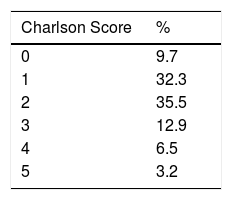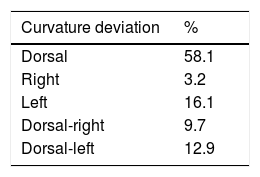Collagenase Clostridium histolyticum (CCH) is the only approved treatment for conservative management of Peyronie’s disease (PD) that has demonstrated efficacy and safety in clinical trials. However, as the standard treatment protocol is time and resource consuming, we are introducing a new CCH treatment protocol with a more cost-effective profile. Our goal is to evaluate its efficacy and safety.
Materials and methodsWe included patients with PD in stable phase, with curvatures of 30–90°. Ventral curvatures and complex deformities were excluded. The treatment protocol consists of a full dose of CCH injected along the PD plaque, forming two lines of four injections. Patients were educated in daily penile modeling activities. The need for a new treatment cycle, up to a maximum of 8 cycles or until the 30° curve was decreased, was reevaluated every 4 weeks. Changes in curvature and number of cycles were recorded to evaluate the efficacy. Regarding safety evaluation, treatment-related adverse events (TRAEs) were recorded, including rupture of the corpora cavernosa, penile hematoma, hematuria, and local infection.
ResultsThirty-one patients were treated under the modified protocol. The mean initial curvature was of 49.84 (±15.83)°. Curvature improvement was recorded in 25 patients (80.6%), with a mean absolute reduction of 20.65 (±15.42)° and relative reduction of 44%. The mean curvature after treatment was 30.67 (±17.25)°. Most patients required one (19.4%) or two (54.8%) injections. No patient presented TRAEs.
ConclusionsThe results suggest that the modified CCH treatment protocol is effective and safe, but more studies should be carried out to optimize the current standard protocol.
La colagenasa de Clostridium histolyticum (CCH) es el único medicamento con licencia para el tratamiento conservador en la enfermedad de Peyronie (EP) que ha demostrado eficacia y seguridad en ensayos clínicos. Sin embargo, el protocolo de tratamiento estándar consume tiempo y recursos, por lo que presentamos un nuevo protocolo de tratamiento con CCH con un perfil más rentable. Nuestro objetivo es evaluar su eficacia y su seguridad.
Materiales y métodosSe incluyeron pacientes con EP en fase estable, con curvaturas de 30–90°. Se excluyeron curvas ventrales y deformidades complejas. El protocolo de tratamiento consiste en una dosis completa de CCH inyectada a lo largo de la placa de EP formando 2 líneas de 4 inyecciones. Se educó a los pacientes en los ejercicios diarios de modelado del pene. La necesidad de un nuevo ciclo de tratamiento fue reevaluada cada 4 semanas hasta un maximo de 8 ciclos o hasta la disminución de la curva de 30°. Para evaluar la eficacia se registraron los cambios en la curvatura y el número de ciclos. Para evaluar la seguridad se registraron los eventos adversos graves relacionados con el tratamiento, incluyendo la rotura de cuerpos cavernosos, hematoma peneano, hematuria e infección local.
ResultadosUn total de 31 pacientes fueron tratados bajo el protocolo modificado. La curvature inicial media fue de 49,84 (±15,83) grados. Se registró mejora en la curvatura en 25 pacientes (80,6%), con una disminución media absoluta de 20,65 (±15,42) grados y relativa del 44%. La curvatura media posterior al tratamiento fue de 30,67 (±17,25) grados. La mayoría de los pacientes requirieron una (19,4%) o dos (54,8%) inyecciones. Ningún paciente presentó eventos adversos graves relacionados con el tratamiento.
ConclusionesLos resultados sugieren que el protocolo de tratamiento modificado con CCH es eficaz y seguro, pero se deben realizar más estudios que ayuden a optimizar el protocolo estándar actual.
Artículo
Comprando el artículo el PDF del mismo podrá ser descargado
Precio 19,34 €
Comprar ahora









